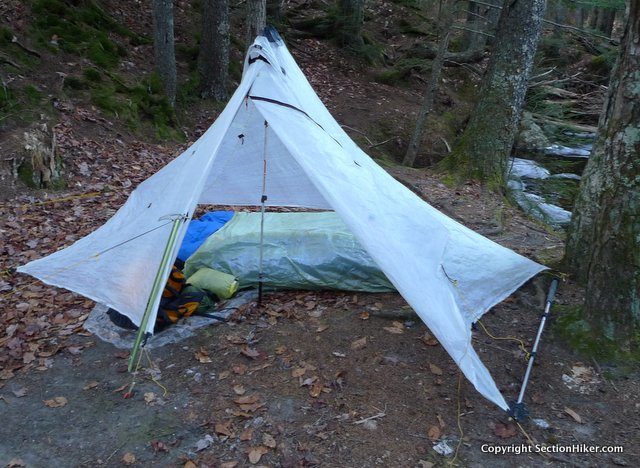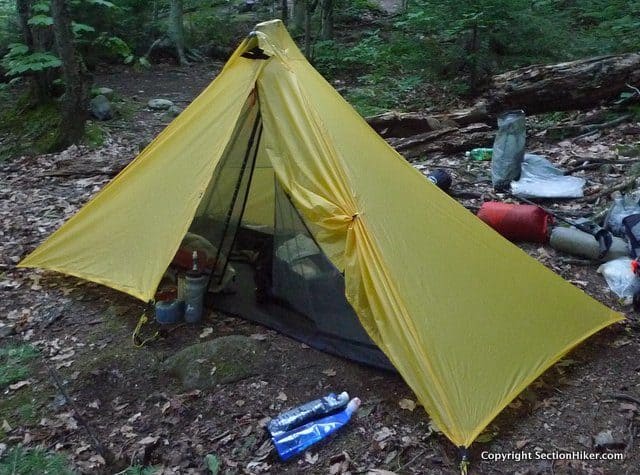
Pyramid tents and tarps are shaped backpacking shelters that can be sized for one, two, or multiple people. Often called "mids", short for pyramids, there are many pyramid tent and pyramid tarps available today ranging from ultralight minimalist shelters to multi-person winter tipis, complete with stove jacks and wood stoves.
Despite their cosmetic or functional differences, all pyramid shelters share a few common properties. They are exceptionally wind and weather resistant, they have a single peak, and solid walls. This makes them a good choice for camping in exposed terrain that doesn't have a lot of natural windbreaks like trees or vegetation, and for winter camping, where the steep side walls of a pyramid can help shed snow.
A Selection of Pyramid Manufacturers and Models
- Black Diamond Mega Lite Tent
- Hyperlite Mountain Gear UltaMid 2, UltaMid 4
- Mountain Laurel Designs Solomid, Solomid XL, Duomid, Duomid XL, Supermid, Mondomid
- Bearpaw Wilderness Designs Luna 2, Luna 4, Luna 6, PyraTent 2, HexaTent 3
- Oware Pyramid Tarps
- Seek Outside Silvertip, Cimarron, and Tipis
- Locus Gear Khufu, Khafra, Menkaura, Hapi, Apollo
- My Trail Company Pyramid 3, Pyramid 4
- Sierra Designs Mountain Guide Tarp
- NEMO Apollo 3P Tarp
- Nigor WickiUp 3, WickiUp 4, WickiUp 5
- Kifaru Tut, Sawtooth, Tipis
Pyramid Tents and Tarps
What's the difference between a pyramid tent and a pyramid tarp? Pyramid tents are usually just pyramid tarps with an optional add-on inner tent that has a floor and mesh netting to protect occupants from ground moisture, insects, and creepy-crawlies. If you use an inner tent with a pyramid tarp, you've effectively turned it into a double wall tent, with all of the advantages and disadvantages commonly associated with them. On the plus side, many pyramid inner tents can be set up after the outer tarp when it's raining, so they stay dry. They're also optional, so you can leave them at home when you want to save gear weight or bulk.

If you opt not to use an inner tent in a pyramid tarp, you can use a lightweight footprint, like tyvek or window wrap, as a waterproof groundsheet, or an ultralight bivy sack with a mesh hood for added insect protection. Another common alternative is to purchase a half-sized inner tent that only fills part of the pyramid to save weight and so you can safely cook in the floorless half in bad weather. Hyperlite Mountain Gear, Bear Paw Wilderness Designs, and Ookworks all sell half mids that can be used for this purpose. When purchasing a pyramid, make sure to look for ones that have interior gear loops or attachment points so you can conveniently suspend accessories in the interior.

Center Pole
Pyramid tents and tarps are called monopole shelters because they only require one pole to set up. The pole is usually placed inside the peak in the center of the pyramid, although it can also be slanted with the base off-center to provide more interior room. The peak itself is usually reinforced so the center pole doesn't puncture it. Most peaks also include an air vent to release the water vapor and warm air that can cause internal condensation.
A pole is often included with the shelter or available as an option. Most smaller capacity pyramids (1-3 people) can be set up with a trekking pole instead of a separate tent pole, which is common with the ultralight pyramids made by cottage manufacturers. If your trekking pole is not long enough, you can lash it to a second trekking pole with a Voile ski strap to create a longer pole, or extend it with a pole jack, which is essentially a tent pole repair sleeve that fits over your trekking pole tip to make it longer.
Front Door
Most pyramid tents and tarps have a single front door, which can be problematic depending on its position and the number of people sharing the shelter. While not an issue for solo use, you're probably going to wake up a partner if you have to get out of a multi-person pyramid at night. When evaluating multi-person pyramids, try to find ones that lets you orient your head facing the front wall so you and your partner(s) have equal access to the door, rather than pyramids where you're lying perpendicular to the door.

Another option is to get a pyramid that is larger than necessary so you have more room inside to move around. For example, the GoLite Shangri-La 3 (now sold as the MTC Pyramid 3) is a spacious 2 person mid, but can be awkward for 3 adults to share given the center pole position and angled front door.
Internal Condensation
Pyramid tents and tarps are prone to internal condensation just like any other single or double-walled tent and shelter. The best way to reduce or eliminate any internal condensation is to maintain as much airflow as possible. While many pyramid shelters have a vent in the peak, this isn't usually sufficient by itself to vent moisture built-up. While sleeping with the front door rolled open in fair weather can be quite helpful, the best way to ensure good airflow is to maintain a wide air gap between the bottom edge of the tarp and the ground so breezes can pass through the tent. Lengthen the center pole a few inches to raise the peak, and stake out the base as normal.

Interior Volume
While the head room at the center of a pyramid tent or tarp is usually quite good, letting you sit up with ease, the interior can be awkward to use depending on the slope angle of the walls and their distance from your face and the top of your feet. While elevating the center pole can help increase the distance between the tarp and your face, there's always going to be less clearance at the edges of the tarp farthest away from the center pole. If this bothers you, look for pyramids with a higher peak height and steeper side walls. The shape of the footprint – circular versus square or rectangular – can also have an impact on in the amount of edge clearance you have. Edge clearance is usually less of an issue in winter because you can dig a pit into the snow under the pyramid to create more headroom.

Campsite Selection
Pyramid tarps and tents have a fairly large footprint, which can make it difficult to pitch in heavily forested terrain where you need to wedge them between trees. They also work best on flat and even ground, unlike a flat tarp, where you can pitch one side considerably higher than the other and still get a viable shelter. If the only ground you can set a pyramid up on is uneven, you're probably going to get some "wall sag" instead of a drum-tight pitch on the high side. This can reduce the amount of useable space you have inside, but is unlikely to have a serious functional impact.
When camping in exposed and windy terrain, it's best to set up your pyramid with the door facing away from the wind or at an angle. You should also stake out the sidewall guy-out points for added security and to prevent wind pressure from bowing the walls into your living space.

Summary
Pyramid tarps and tents are a popular ultralight backpacking shelter option because they're relatively lightweight and wind resistant. If sleeping on the ground doesn't appeal to you or if you need insect protection, you can add an inner tent to a pyramid tarp to create a double-walled tent. Internal condensation is best addressed by encouraging plenty of airflow through a pyramid, by keeping the front door open or pitching them so plenty of air can blow through, low down near the ground. Most ultralight backpacking pyramids can be set up using a trekking pole(s), but you can usually obtain and carry a separate tent pole if you don't use them. Pyramids work best on flat ground with fairly open campsites because they require a fair amount of space to set up and stake down. While headroom is quite good in the center of a pyramid, the ends can be quite low above your face or the tops of your feet. This can be addressed by getting a larger capacity pyramid that provides more living space, although it will be heavier to carry.
Written 2018.
Support SectionHiker.com, where we actually field test the products we review. If you make a purchase after clicking on the links above, a portion of the sale helps support this site at no additional cost to you.See Also:
- Ultralight Backpacking Tent and Shelter Guide
- Mountain Laurel Designs Duomid Review: Long Term Review
- My Trail Company Pyramid 3 Review
- Bear Paw Wilderness Designs Luna 2 Review
The post Ultralight Backpacking Pyramid Tent and Tarp Primer appeared first on Section Hikers Backpacking Blog.
from Section Hikers Backpacking Blog http://ift.tt/2rrQlsU
No comments:
Post a Comment